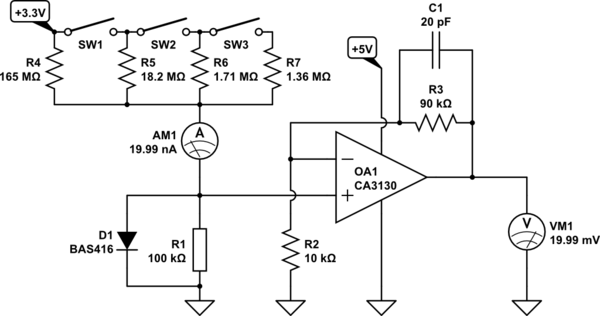there is a large measurement error caused by the not high enough DC input resistance of the DMM
You're saying that the 10MΩ input resistance of a bench DMM is not high enough? That's 10V/μA sensitivity, or 10mV/nA (!). I've checked and my DMM will happily measure currents down to a fraction of a pA that way. In Volts mode.
No need for op-amps. Yes need for cleanliness. Touching the PCB may well leave enough conductive residue to obscure the results. Would be best if you had an ultrasonic cleaner and cleaned the board in isopropyl followed by deionized water. Soldering flux residue may not be great either, depending on the flux type.
The sensing resistor is the input resistance of the DMM. You can parallel something with it to yield 1MΩ parallel combination. Obviously it will be higher than 1MΩ :)
If you want to use an op-amp, a CA3130 (70s vintage) or CA3130A (slightly newer lower offset variant) will have no problem measuring things. 1MΩ input impedance is excessive though when you use an op-amp. 100kOhm, gain 10, gives 1mV/nA on the output:


simulate this circuitsimulate this circuit – Schematic created using CircuitLab
This circuit will measure up to about 4μA with reasonable accuracy. Above 4μA the diode starts taking shunting the sense resistor R1, keeping the CPU functional even if it happens to wake up from sleep. You may find that helpful. I certainly did :)
CA3130CA3130[A]/4040[A] have offset nulling inputs. See the datasheet for how to use them. This will let you get better than 1nA accuracy at room temperature without much fuss.
CA3130CA3130[A]/4040[A] also has common mode range that extends about 0.5V below ground, so this circuit will work well down to 0.0nA.
The output of the op-amp is a CMOS inverter and will swing within mV of the rails as long as it's lightly loaded.
This is a retro circuit on purpose. You can use much newer and better op-amps, but the only real improvement will come from lower input noise. I have inherited components from an old lab and have rails of those chips, thus I tend to use them. Hard to beat free :)
Also, since the circuit is so simple, you can assemble it without a PCB, just on a piece of ground plane of your choice, with teflon standoffs.
